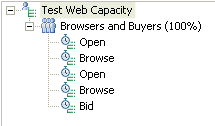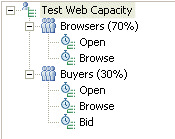User groups enable you to group tests in a logical order.
With user groups, you can control test execution in several ways:
- Group tests by characteristics. For example, you could have two user groups—a Buyers group and a Browsers group—that represent the types of users on your system.
- Influence the order in which tests are run. When you run a schedule, the first test in each user group runs—in parallel, not sequentially. After the first test in a user group is completed, the second test runs, then the third, and so on.
The following schedule contains one user group.

The following schedule contains the same tests in the same order,
but they are divided between two user groups. Conceptually, this schedule
is easier to understand, because the user's tasks are grouped logically—the
Browsers browse, and the Buyers browse and then bid on a product. But, even
more important, this schedule is a more accurate representation of the types
of users on your system, because each user group contains tests that represent
the actions that they do, and the proportions of the user groups (70% and
30%) represent the proportions of the users on your system.
